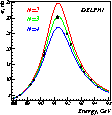
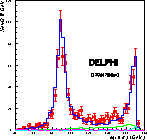
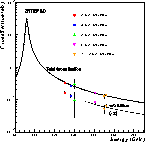
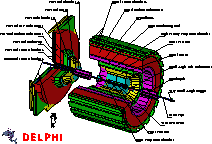 The DELPHI Detector (.ps)
The DELPHI Detector (.ps)

|

|

|
| Scan at the Z (.ps) | Effective sqrt(s) at 172 GeV (.ps) | Autoscan above the Z (.ps) |
One of the primary aims of LEP experiments running at the Z peak is to
make precise tests of the "Standard Model". The mass and the
width of the Z resonance are obtained with high precision from a scan,
by measuring the cross section at a few accurately know beam energies in
the vicinity of the peak. The most precise results are obtained from the
hadronic cross section, as the Z decays mainly to quarks (left figure).
The width of the Z allows to determine the number of (low mass) neutrinos
which, as illustrated by the curves on the figure, amounts to three. This
makes it very plausible that the number of elementary particle families
is also limited to three.
At energies well above the Z peak, the fraction of events in which an energetic
photon is emitted by the incoming electron or positron becomes larger.
The effective interaction energy is then smaller, due to the emitted photon,
and it displays a peak at the beam energy and a second peak at the position
of the Z, over a continuum (center). The radiation can be used to measure
the hadronic cross section below the nominal interaction energy ("autoscan",
right).
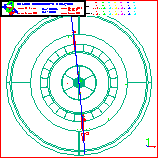
|
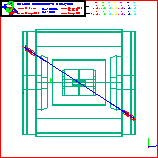
|
| Z -> e+ e- (.ps) | Z -> mu+ mu- (.ps) |
The measurement of the decay branching ratios of the Z to lepton pairs
provides additional information to test the Standard Model.
An example is e+ e- --> Z --> e+ e- (left) where the electrons are
identified by showers in the HPC.
Another example is e+ e- --> Z --> mu+ mu- (right) with the forward
muons identified by minimum ionising signals in the hadron calorimeter
and hits in the muon chambers.
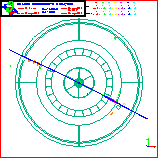
|
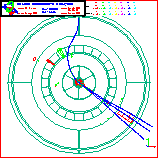
|
| Z -> tau+ tau- -> mu nu + e nu (.ps) | Z -> tau+ tau- -> hadrons (.ps) |
The third case is e+ e- --> Z --> tau+ tau- where the taus are observed
by their decay products: a neutrino accompanied by an electron, a muon
or one or several hadrons. The picture on the left shows one decay to an
electron, the other to a muon. The leptonic decay channel is the one in
which the first evidence for the tau was produced. The picture on the right
shows a tau decaying into three charged particles and the second tau into
one charged particle and a pi0 (probably coming from the decay to rho).
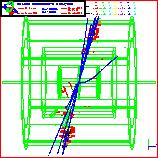
|
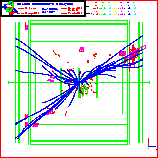
|
| Z -> 2 jets | Z -> 3 jets |
A typical event from the disintegration of the Z is a decay into a q-qbar
pair, with negligible gluon radiation. This events is clearly seen as two
collimated jets, defining the event axis (the probability of hard photon
radiation off the Z is much smaller than above the Z). Gluon radiation
might cause the hadronic events to appear as a three-jet topology. The
energy of the radiated gluon is normally smaller than the energy of the
radiating quark. Four-jet events can be due to double hard gluon radiation,
but they can be also the signature of the production of a pair of particles
decaying hadronically. They are thus studied in the context of new physics.
An example of a 4-jet event is given by the first WW pair observed at LEP
(below).
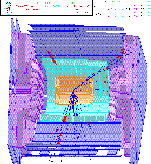
|
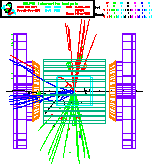
|
| Seen radiation | Unseen radiation |
Above the Z, the smallness of the photon exchange cross section compared
to the Z cross section causes the increase of the probability of radiating
hard photons ("radiative return"). On the left an event of radiative
return in which the photon is reconstructed in the electromagnetic calorimeter.
The probability of photon emission being larger at small polar angles,
in 80% of the cases the radiated photon is lost in the beam pipe (center),
and it has to be reconstructed from the momentum unbalance. Finally, in
some events, the return to the Z happens via double photon emission (with
both photons detected).

|
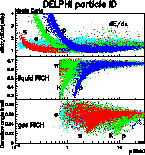
|
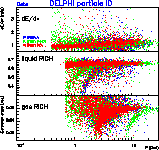
|
| Operation of the RICH | Performance of particle ID (simulation) | Performance of particle ID (real data) |
The particle identification system in DELPHI combines the information
from the specific energy loss by ionization (dE/dX) in the TPC and in the
VD with the Cherenkov angles measured by two RICH (Ring Imaging CHerenkov)
radiators. The RICH detection technique is founded on the Cherenkov effect.
This takes place when a charged particle travels faster than the speed
of light in the medium of propagation: the particle emits photons on a
cone whose axis is the particle trajectory. The opening angle (theta) of
this cone is given by cos(theta) = 1/(beta*n), where beta is the speed
of the particle (v/c) and n is the medium refractive index. The cone is
reconstructed as shown on the left. To cover the full momentum range at
LEP I (right), DELPHI uses two radiators, with different refractive indices:
one liquid and one gaseous. The results on the central transparency
are obtained by simulation; the results on the right plot from
real data, when pions are sampled by K0_s disintegrations, protons by Lambda decays, and charged K by D0 and phi decays.
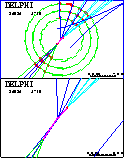
|
|
| The DELPHI VD | Reconstructed B decays |
The b quark is the heaviest produced at LEP. Its
relatively long lifetime (about 1.6 ps) causes its decay products to
have sizeable impact parameters (distances of closest approach) with respect
to the primary vertex, of the order of hundred microns. To be sensitive
to such distances, DELPHI is equipped with a silicon microvertex
detector with intrinsic resolution of the order of 10 microns, well below
the need for the detection of the decays of hadrons containing the b
quark (B hadrons). The layout of the DELPHI Vertex Detector is shown on the left;
on the right, the decay of a B hadron.
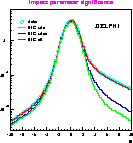
|
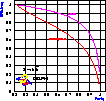
|
| Impact parameters | B Tag Performance |
The distribution of the significance (defined as the impact parameter divided
by its error) is shown (left) for real data and for the different contributing
quarks in the simulation. The larger significance in B events is used to
tag the b-bbar events. The performance of the algorithm is shown in the
figure on the right, which shows the purity (i.e., the fraction of real b events
in the tagged sample) versus the efficiency (the fraction of b events
actually tagged). The two curves represent the cases in which the
selection is based on all tracks in the event and on the tracks from
a single b jet only.
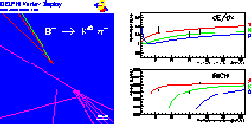 Postscript (357kB)
Postscript (357kB)This is an example of the powerful combination of the particle identification
system with the high resolution of the Vertex Detector. The charmless B
decay is unambiguosly reconstructed. The VD detects the displaced secondary
vertex. The charged Kaon from the B decay is seen by the RICH gaseous radiator,
and confirmed by the TPC dE/dX.
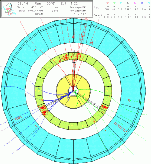
|
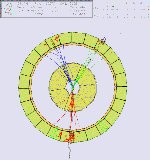
|
| A Mercedes event | A Y event |
The LEP detectors can select gluon jets in b-bbar-gluon events, by lifetime
tagging of the b quark jets. In order to remove kinematical biases, events
with 3-fold symmetric topology ("Mercedes events") and with 2-fold
symmetric topology ("Y" events) are used.
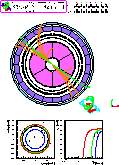 Postscript (3 MB)
Postscript (3 MB)
The DELPHI performance for particle identification can be used to select
s-sbar events by tagging leading charged kaons
by means of the gaseous radiator of the RICH detector
(nonleading charged kaons have a softer spectrum than the primary ones).
Here a spectacular case in which two charged kaons back to back (of 13.6
and 20.1 GeV of energy respectively) are identified.
The reconstruction of the Cherenkov ring
related to the most energetic K is shown in the left lower
plot (the photons represented by closed circles are the ones for which the
reconstruction is most reliable).
In the lower right plot the Cherenkov angle for both kaons is
compared to the expectation in the pion (red), proton (blue) and K (green)
mass hypothesis, showing that the kaon hypothesis is strongly preferred.
 Postscript (52kB)
Postscript (52kB)The barrel electromagnetic calorimeter of DELPHI has its strong point
in its excellent granularity. Here an example of how a neutral pion with
an energy of about 30 GeV can be distinguished from a photon of about the
same energy simply by the transverse profile of the energy deposit.
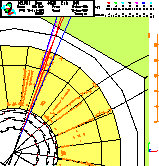 Postscript (52kB)
Postscript (52kB)The reconstructions of the vertices K0s -> pi+ pi- and Lambda -> p pi are performed with typical efficiencies of 40% and 30% respectively, with a combinatorial background below 5% and below 15%.
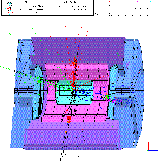
|
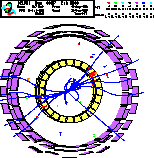
|
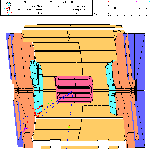
|
| 4-quark decay | mu nu + 2 quarks | mu nu + tau nu |
Examples of W pairs produced in the 161 GeV energy run. The two W can both
decay into quarks (in 4/9 of the cases); one can decay in two quarks, the
other into a lepton plus a neutrino (another 4/9), or both can decay into
a lepton and its neutrino (1/9 of the cases).
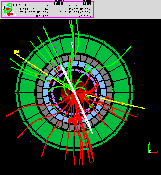
|
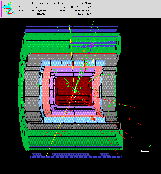
|
| xy shaded view | zx shaded view |
Example of candidate Z0Z0 event from the 183 GeV run in 1997.
One Z decays into a Mu-Mu (in yellow) and the
other into a quark-antiquark pair.
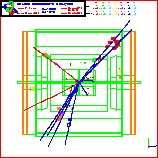 Postscript
Postscript This event contains two quark jets (particles in blue) and two muons
(in red) very clearly separated from the jets. The large separation makes
it very unlikely to originate from two semileptonic decays of b quarks.
A more probable explanation is Z --> q-qbar-gamma where the gamma materialises
into the muon pair (4-fermion event).
On the other hand, this event illustrates beautifully the topology expected
for the production of a Higgs particle in association with a Z. The Higgs
would decay into the jets and the (off-shell) Z into the muon pair. This
event was recorded amongst the first 13000 hadronic events from DELPHI
in 1989. In the more than 3 million events taken after this, no second
example was found with such striking characteristics.